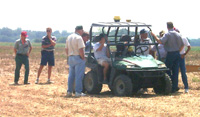KPAN Gives Farmers Networking Opportunities
KPAN Gives Farmers Networking Opportunities

Kentucky Precision Agriculture Network members shared their experiences with emerging technology during their recent summer meeting.
Precision agriculture refers to a method of site-specific farm management using various technologies such as global positioning systems (GPS), geographic information systems (GIS), yield monitoring technologies, and automated vehicle guidance.
The idea behind this technology is to improve farm profitability while minimizing environmental losses by doing the right thing, at the right location, at the right time and in the right way.
KPAN was formed earlier this year with the concept being to get farmers to communicate with each other and to get the communication set up to allow that to take place, said Mike Ellis, a Shelby County farmer and chair of KPAN's development committee.
"The hope is that now that we have e-mail, that it's instant and we all the sudden have a neighbor half way across the state we can e-mail back and forth with and try to help each other," he said. "So, it makes us closer together and flattens the plain somewhat."
The group is seeking funding to build and maintain a web site.
At the Aug. 7 meeting and field tour, some of the latest research by the University of Kentucky and private enterprise was discussed.
"I was encouraged by the conversations that took place," Ellis said.
Agricultural engineers from the University of Kentucky College of Agriculture discussed with farmers what they need to consider when looking for a GPS receiver or a light bar, which is used for parallel tracking in fields.
Scott Shearer, UK Extension agricultural engineer, said when reviewing GPS receivers a person should look at update rates, accuracy, compatibility, correction capabilities, reliability, service after the sale and expected life of the equipment.
Today's equipment holds up well under field conditions, Shearer said. But not all receivers are equal when it comes to accuracy. Accuracy is important because the error range can mean a difference between the receiver indicating a position in your field, or a neighbor's field.
One problem with accuracy is that manufacturers tend to use different methods when reporting it. Shearer said farmers need to be cautious if a piece of equipment is rated using either CPE or 1 Sigma methods, as these ratings differ from more common approaches.
Extension agricultural engineer Tim Stombaugh said there is no way yet to measure accuracy with light bars. When looking for a light bar, farmers need to consider if it will work with their current GPS equipment and its ease in programming.
A panel of light bar users discussed their experiences with the technology in planting, spreading fertilizer and applying chemicals. Using the light bar enables the driver to determine if he's in the right position in the field of if he needs to move to one side or the other.
Mickey Howard, who applies various agricultural products for farmers, said he is sold on them. Light bars work especially well when applying something like chicken litter which is difficult to see on the field. The light bar eliminates the guess work on whether you are missing a spot or overlapping.
Also during the tour, UK Soil scientist Tom Mueller, discussed some work that he and his students have done relating soil electricity conductivity (EC) with soil properties and yield. This work was supported in part by the Kentucky Corn Growers Association.
The work has shown that soil EC is correlated with depth of topsoil in the first 19 inches of soil and depth of fragipan. Both limit the amount of water available to the plant because roots have difficulty penetrating subsoil and fragipans. Eroded soils tend to have very high conductivity readings.
"EC also relates well with yield. It does not predict yield during any given year but rather it seems to be more related to yield potential," Mueller said. "With low conductivity values you can have high or low yields, but as conductivity values increase, the maximum possible yield decreases.
"This is a relationship that we have seen across years and crops in several fields examined from central Kentucky and the Purchase area," he said. "If yield potential is known, we can begin to ask why certain regions of the field are not producing to their potential. Is it because fertility levels were not optimal or other problems."
Mueller also suggested that EC may be a useful tool for making fertilizer recommendations.
"The work of (UK agronomist) Richard Barnhisel suggests that soil type and depth of soil can be used as a basis for making variable rate fertilizer, nitrogen and seeding rate decisions," he said. "Because EC has a linear relationship with top soil in the first 19 inches of soil depth, we may be able to utilize EC in these recommendations."
Mueller sees potential for soil EC to help Kentucky farmers but expresses caution. "Hopefully, we can develop guidelines for Kentucky farmers for using EC to enhance profitability, but we are not there yet."
The KPAN summer tour was hosted by Miles Farm Supply. Crop consultants with the Owensboro organization discussed their research on compaction, remote sensing, and planter calibration.
For more information on KPAN, contact Mike Ellis at wdemike@iglou.com.